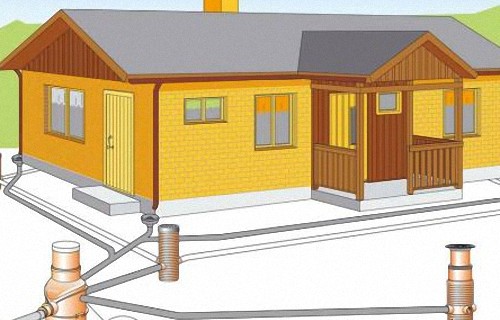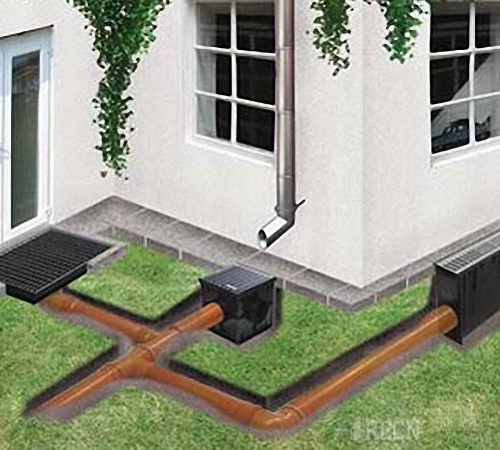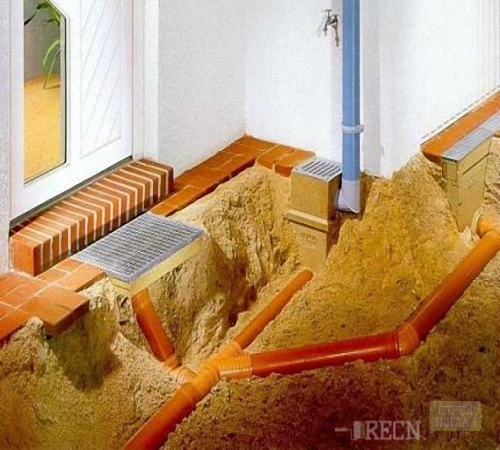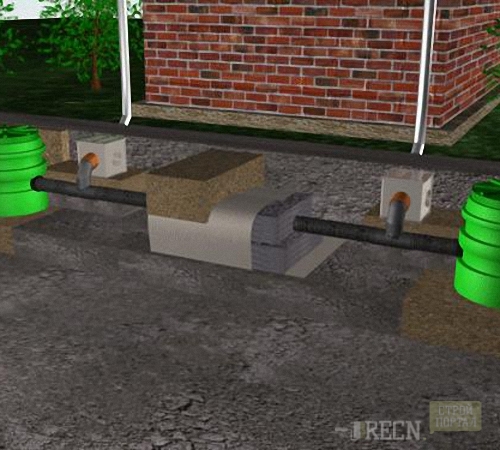
Installation of storm sewer with your own hands Construction

Every year a certain amount of precipitation falls. There is a huge amount of precipitation on the root of buildings. It requires a special system for their collection, namely, a storm sewage device. Everyone can protect the overlap by making a similar system with their own hands.
In order to make storm sewers - you need to know what it represents. After all, this is not only drainage pipes hanging from the roofs. But are only part of the truth, not the most insignificant, in the drain system.
Content
If you try to figure out the storm sewage device in order, it will be necessary to allocate some separate items:
- Collection system;
- Wireless drainage system;
- Recycling system.
Here in each individual plot uses similar principles corresponding to each system of drainage. There are two ways to create such a device: linear and dotted water drain. The simplicity of such systems allows you to apply a scheme for both the water lead from the roof and from the entire land plot. Moreover, real and combined installation of storm sewage, embodying both categories.
Installation of storm sewage
Storm sewer, as described above, can be mounted in three types:
- combined system
- envelope system
- linear system
Such a sewer system consists of:
- vertical area riser
- drainage funnel
- washing pipes
- waterborne gutter
- wells of storm sewage
- hydraulic shutters
- waterproof tower
- closed release to the collector
- loaded holes for cleaning
- terrestrial rain-seeker
- open release of precipitation for the local territory
Installation of storm sewage starts from all effluents from the intended territory. They are stacked by a small inclination, for the sake of water from the receptional funnels. This is the envelope type of installation. Next, the drain should fall into the system of complete drainage outside the site.
As for a linear lead, then the drains from the separately taken section are adjacent to the groove, an "elongated" receiver, and depart into the drainage system. Then everything moves through the scheme described above.
After that, the storm sewage system itself is already entering into force, where the liquid enters the central collector using pipes or trays.
Drainwater, practically, does not blame the pollution effect, and the septicchka will let it in processing, as having waste, and overloaded over time. Therefore, part of the system is reasonable to make for economic needs, placing such water into a separate drive. And another part is simply discharged into the external environment. This is the so-called, storm sewage is outdoor.
Calculation of the storm sewage and its components

If the roof is flat, the collation to collect the envelope system is limited. Therefore, the correct calculation of the storm sewage and its structure is very important for such a structure. To remove water direction of water "Against current", a particularly complex design is required. This is not at all profitable. Moreover, for a flat roof, in most cases, the labeling sewage laying is characterized by a linear method. This technology is created if the house has a complex roof configuration, or a large flat roof. Before you start mounting the storm sewer with your own hands, calculate it.
The secession of the water collection system you need is determined only by its bandwidth, as well as the rainfall of your region. And the entire area, and for the roof, it is calculated equally, thanks to the formula:
Q \u003d Q20 ∙ F ∙ φ
Here is the concept Q. It is the volume of water required for the discharge.
φ - This is the surface coefficient of water absorption.
Concept q20. It embodies the intensity of the rain, namely l / s per 1 hectare, for separate terrain.
F. In this case, it is a certain area of \u200b\u200bstorm sewage from which precipitation will be collected.
Installation of storm sewage
Basically, laying the storm sewer is not enough than different from the household. Possible discrepancies here can be only 1-2%. The diameter of the storm sewage can average 13 cm. By factory standards.
To begin with, consider the installation of the roofing part:
- To mount rain-seekers, we pierce the holes in the overlap.
- The devices are then laid on bitumen mastic. It is necessary to thoroughly induce the adjoining.
- Step pipes for the point system are installed using suspension. For a linear system, team trays are going.
- After that, we set the risers (point system), or drainage pipes (linear system).
- Next, mount the closed emission node into the collector, or is an open output to the traumatic system.
All installation occurs with a clamping fastener to overlaps or walls. Each place of installation in front of the direct installation must be preloaded by observing the slopes. All kinds of storm sewage design obliges to observe a small bias for pipes.
Storm sewage is outdoor, and its laying
To lay the storm sewer in the outer part, you will need to do the following items:
- Get a tool and cable
- Perform the trace of the territory, namely, note the lines of the future passage of drainage trays, pipes, wells and a central collector, or lowering the surface.
- Next, you need to dug trenches and pits, following marking. This is done for the future sewer well. We put the pipes below the depth of the soil freezing.
- For trays dig grooves.
- We establish terrestrial raids.
- Then the sand pillow is laid into the dug grooves and trenches, and it is thoroughly tamped.
- After laying of pipes and trays occurs.
- Next, we connect the well, rain-seekers, sandcloths, and the main collector to the pipes.
- When the pipes are laid in the ground, tearing them, like all other sewage elements.
- The trays are fastened with a solution on grilles for storm sewage.
- At the end of the installation of storm sewer, we rinse the entire system. This process must be started with the roof, and continue as the flow rate.






















